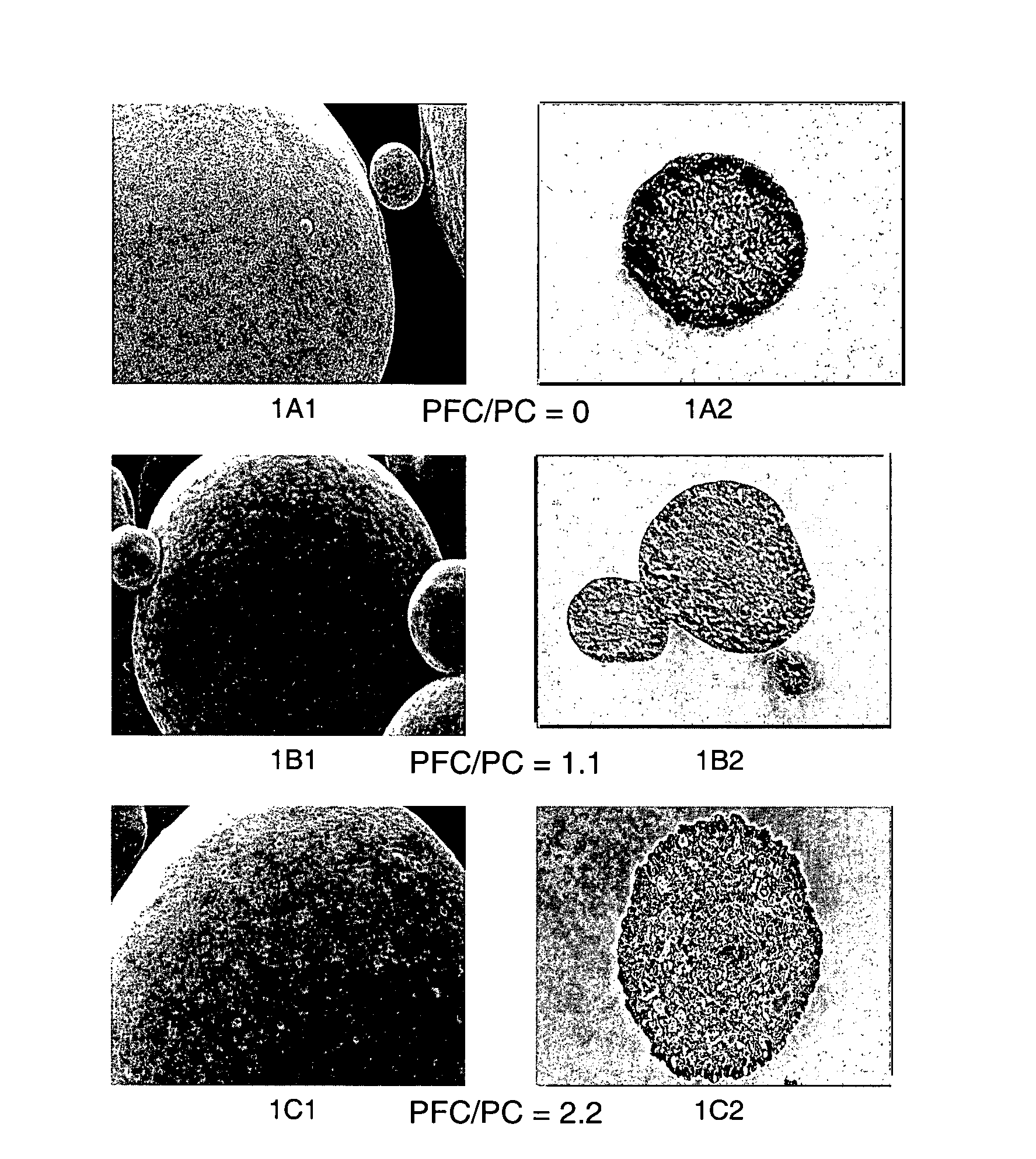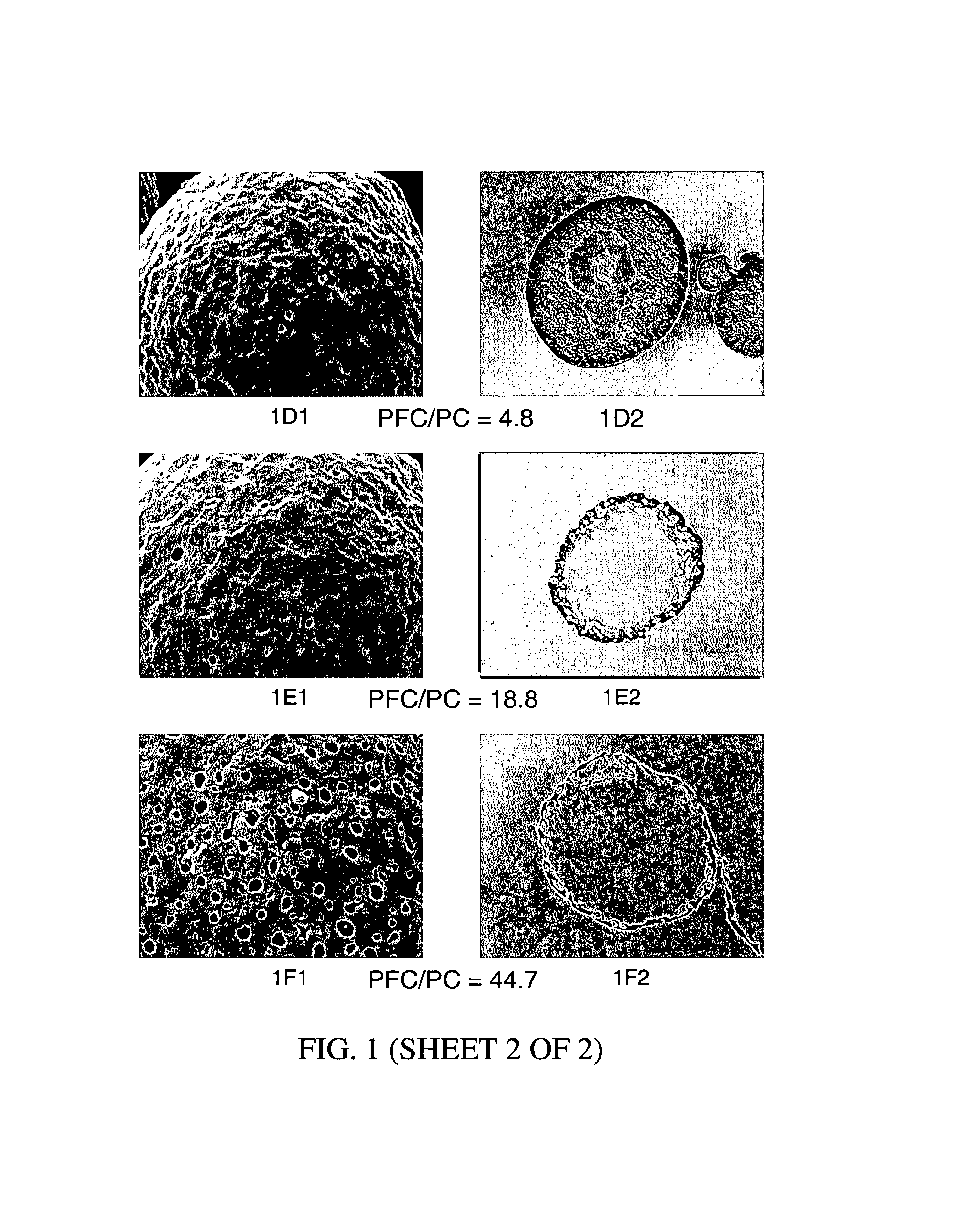Engineered particles and methods of use
a technology of microstructures and particles, applied in the direction of aerosol delivery, spray delivery, antinoxious agents, etc., can solve the problems of limiting their use, many of the surfactants that were effective in stabilizing drug suspensions in cfcs are no longer effective in these new propellant systems, and poor wetting of medicament particles
- Summary
- Abstract
- Description
- Claims
- Application Information
AI Technical Summary
Benefits of technology
Problems solved by technology
Method used
Image
Examples
example iv
[0192 illustrates that the physical characteristics of the blowing agent (i.e., boiling point) greatly influences the ability to provide perforated microparticles. A particular advantage of the present invention is the ability to alter the microstructure morphology and porosity by modifying the conditions and nature of the blowing agent.
V
Preparation of Spray Dried Albuterol Sulfate Particles using Various Blowing Agents
[0193]Approximately 185 ml of the following solutions were prepared for spray drying:[0194]49% w / w Hydrogenated Phosphatidylcholine, E100-3 (Lipoid KG, Ludwigshafen, Germany)[0195]50% w / w Albuterol Sulfate (Accurate Chemical, Westbury, N.Y.)[0196]1% w / w Poloxamer 188, NF grade (Mount Olive, N.J.)[0197]Deionized water.
Blowing Agents:[0198]Perfluorodecalin, FDC (Air products, Allenton Pa.)[0199]Perfluorooctylbromide, Perflubron (Atochem, Paris)[0200]Perfluorobutylethane F4H2 (F-Tech, Japan)[0201]Perfluorotributylamine FTBA (3M, St. Paul, Minn.)
[0202]Albuterol sulfate po...
example v
[0211 further demonstrates the wide variety of blowing agents that may be used to provide perforated microparticles. A particular advantage of the present invention is the ability to alter the microstructure morphology and porosity by manipulating the formulation and spray drying conditions. Furthermore, Example V demonstrates the particle diversity achieved by the present invention and the ability to effectively incorporate a wide variety of pharmaceutical agents therein.
VI
Preparation of Hollow Porous PVA Particles by Spray Drying a Water-in-Oil Emulsion
[0212]100 ml of the following solutions were prepared for spray drying:[0213]80% w / w Bis-(2-ethylhexyl) Sulfosuccinic Sodium Salt, (Aerosol OT, Kodak, Rochester, N.Y.)[0214]20% w / w Polyvinyl Alcohol, average molecular weight=30,000-70,000 (Sigma Chemicals, St. Louis, Mo.)[0215]Carbon Tetrachloride (Aldrich Chemicals, Milwaukee, Wis.)[0216]Deionized water.
[0217]Aerosol OT / polyvinyl alcohol particles were prepared by spray-drying tech...
example vi
[0225 further demonstrates the variety of emulsion systems (here, reverse water-in-oil), formulations and conditions that may be used to provide perforated microparticles. A particular advantage of the present invention is the ability to alter formulations and / or conditions to produce compositions having a microstructure with selected porosity. This principle is further illustrated in the following example.
VII
Preparation of Hollow Porous Polycaprolactone Particles by Spray Drying a Water-in-Oil Emulsion
[0226]100 mls of the following solutions were prepared for spray drying:[0227]80% w / w Sorbitan Monostearate, Span 60 (Aldrich Chemicals, Milwaukee, Wis.)[0228]20% w / w Polycaprolactone, average molecular weight=65,000 (Aldrich Chemicals, Milwaukee, Wis.)[0229]Carbon Tetrachloride (Aldrich Chemicals, Milwaukee, Wis.)[0230]Deionized water.
[0231]Span 60 / polycaprolactone particles were prepared by spray-drying technique by using a B-191 Mini Spray-Drier (Büchi, Flawil, Switzerland) under t...
PUM
 Login to View More
Login to View More Abstract
Description
Claims
Application Information
 Login to View More
Login to View More - R&D
- Intellectual Property
- Life Sciences
- Materials
- Tech Scout
- Unparalleled Data Quality
- Higher Quality Content
- 60% Fewer Hallucinations
Browse by: Latest US Patents, China's latest patents, Technical Efficacy Thesaurus, Application Domain, Technology Topic, Popular Technical Reports.
© 2025 PatSnap. All rights reserved.Legal|Privacy policy|Modern Slavery Act Transparency Statement|Sitemap|About US| Contact US: help@patsnap.com



